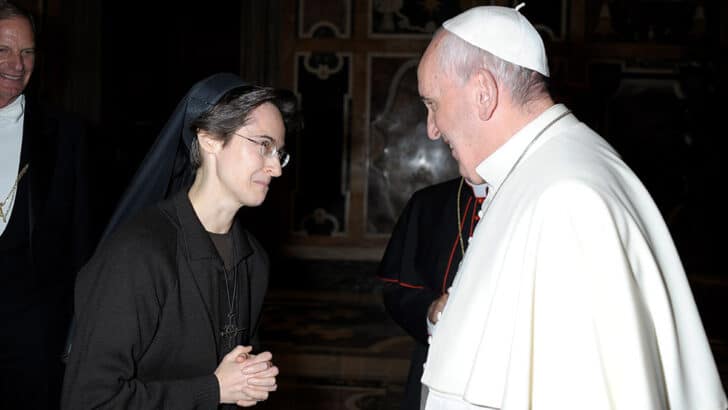The role of women in the Church is contentious, even among Catholic women. Some believe that women will never be truly equal in the Church unless they are admitted to the ordained priesthood.
Some emphasise women’s primary roles within family and parish settings. Others advocate for greater inclusion of women’s voices at all levels of the Church but caution that prioritising ordination could perpetuate clericalism, where ordination is equated with power rather than service.
Pope Francis belonged to the latter category. In late 2024, in an address to fellow Jesuits from Belgium, Luxembourg, and the Netherlands, he said, “The Church is woman,” in response to a question about “the difficulty of giving women a more just and adequate place in the Church.”
The Pope said he did not want to limit the discussion of women’s roles to the question of ministry. He was trying to bring “more and more women into the Vatican with roles of higher and higher responsibility.”
“Things are changing,” he continued. “You can see and feel it.”
Responsibility
The Pope has appointed more than 20 women to important roles of responsibility within the Vatican. The latest was the promotion of Sr Raffaella Petrini (56) an Italian nun, from second-in-command to the first woman governor of the Vatican City State. She will also be the President of the Pontifical Commission for the Vatican City State, and in that role, will rank higher than the six Cardinals who are members of the Commission.
She is the second religious sister to outrank Cardinals; the first was Sr Simona Brambilla, prefect of the Dicastery for Institutes of Consecrated Life and Societies of Apostolic Life. This is the first time in history that women have held higher positions in the Vatican than men.
He also appointed women who could vote at the Synod on Synodality, another first”
Many of the women appointed by Francis are religious sisters but not all. Francesca Di Giovanni is an Italian lawyer who has worked in the Vatican Secretariat of State since 1993. In 2020, she was the first woman or indeed, layperson, to be appointed as an Undersecretary for Multilateral Affairs in the Section for Relations with States of the Secretariat of State, an important diplomatic post.
Other laywomen play important roles in the Vatican, including six women appointed in 2020 to the 15-member Council for the Economy, which oversees Vatican finances. Ruth Kelly, a former UK minister in Labour governments under Tony Blair and Gordon Brown, is one of them.
He also appointed women who could vote at the Synod on Synodality, another first. This included two Irish women, Sr Patricia Murray IBVM (Loreto Sisters) and Sr Mary Teresa Barron OLA (Sisters of Our Lady of Apostles).
Importance
Pope Francis’s strategy seems clear. He wanted to include women in decision-making at the highest level, including formally consulting them about the selection of bishops.
However, to see Pope Francis as someone whose focus is simply inserting women into important roles is to miss a great deal.
One of his first actions as Pope was to visit Lampedusa to show solidarity with migrants”
The most important woman in Pope Francis’ life may have been his grandmother. He spoke fondly of her on many occasions, including when she chased a thief with a broom from the shop they owned. More importantly, his nonna (grandmother) Rosa taught him his prayers and to love God. He said that he “had the grace to grow up in a family where faith was lived in a simple and concrete way; but it was above all my grandmother, my father’s mother, who marked my path of faith.” He kept what he called her testament of faith in his breviary, which was a prayer for all her grandchildren.
Her difficult journey from Italy to settle in Argentina also shaped his love and concern for migrants. One of his first actions as Pope was to visit Lampedusa to show solidarity with migrants attempting to cross into Europe.
Pope Francis has emphasised developing a theology of women that respects difference but also acknowledges what he calls the “genius of women.”
Principles
Pope Francis has frequently referenced the Petrine and Marian dimensions of the Church, a concept initially articulated by Hans Urs von Balthasar. In essence, the Marian principle is linked to Mary, the mother of Jesus, symbolising the Church’s receptive, nurturing, and spiritual nature. The Petrine principle, tied to Peter, supports the Church’s institutional identity, highlighting apostolic continuity and hierarchical structure. The two principles are inseparable. Pope Francis stresses that the Marian principle is foundational: the Petrine (institutional) dimension cannot exist without the Marian (spiritual) dimension.
Some women bristle at this distinction, seeing it as just another way to exclude women from governance. But Pope Francis actively encouraged women in leadership. There are many underutilised ways in which women could exercise leadership at different levels, from diocesan chancellors to theological experts. It will be part of Francis’ legacy that he has opened the door to more women assuming these roles.


 Breda O'Brien
Breda O'Brien
